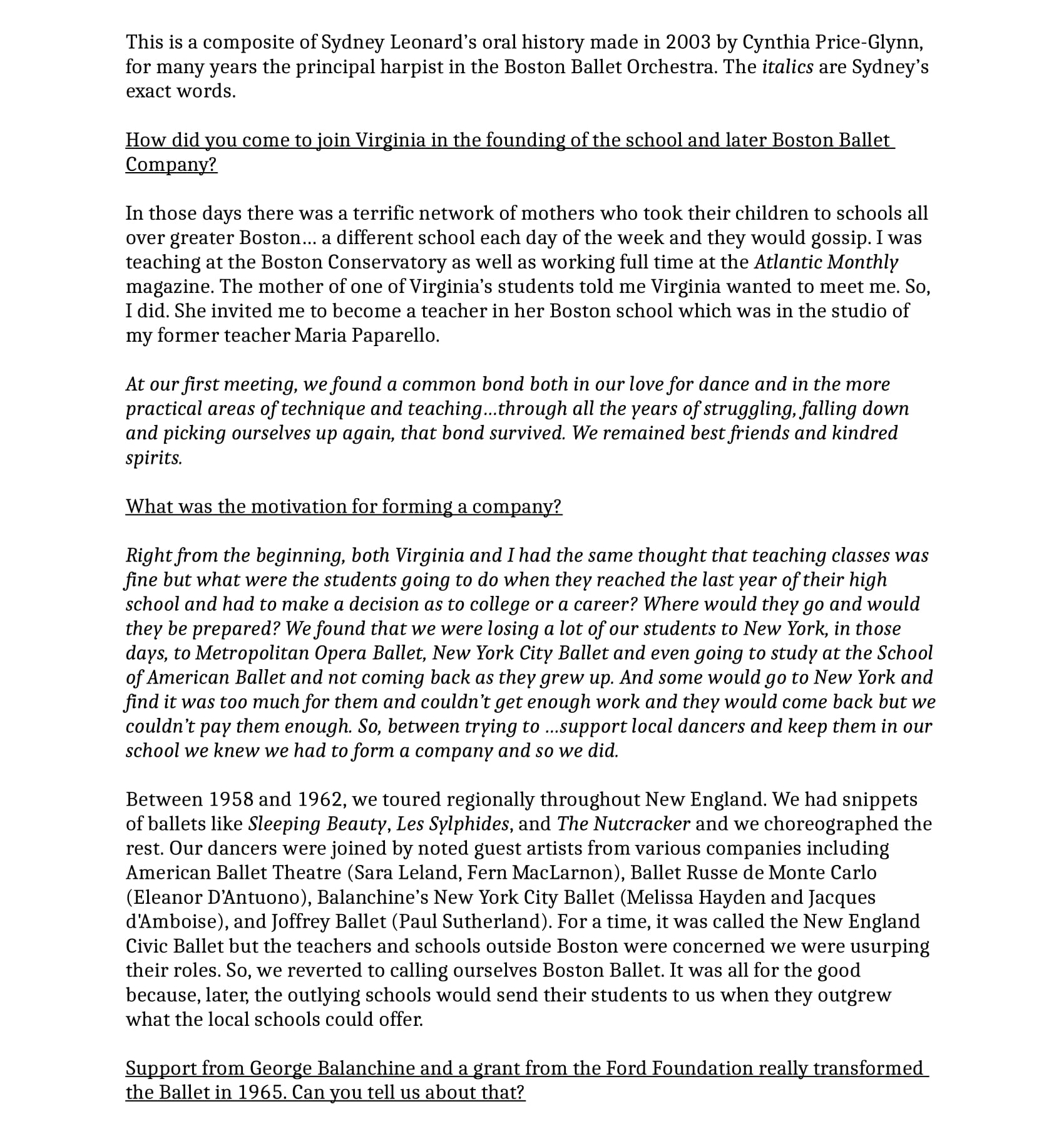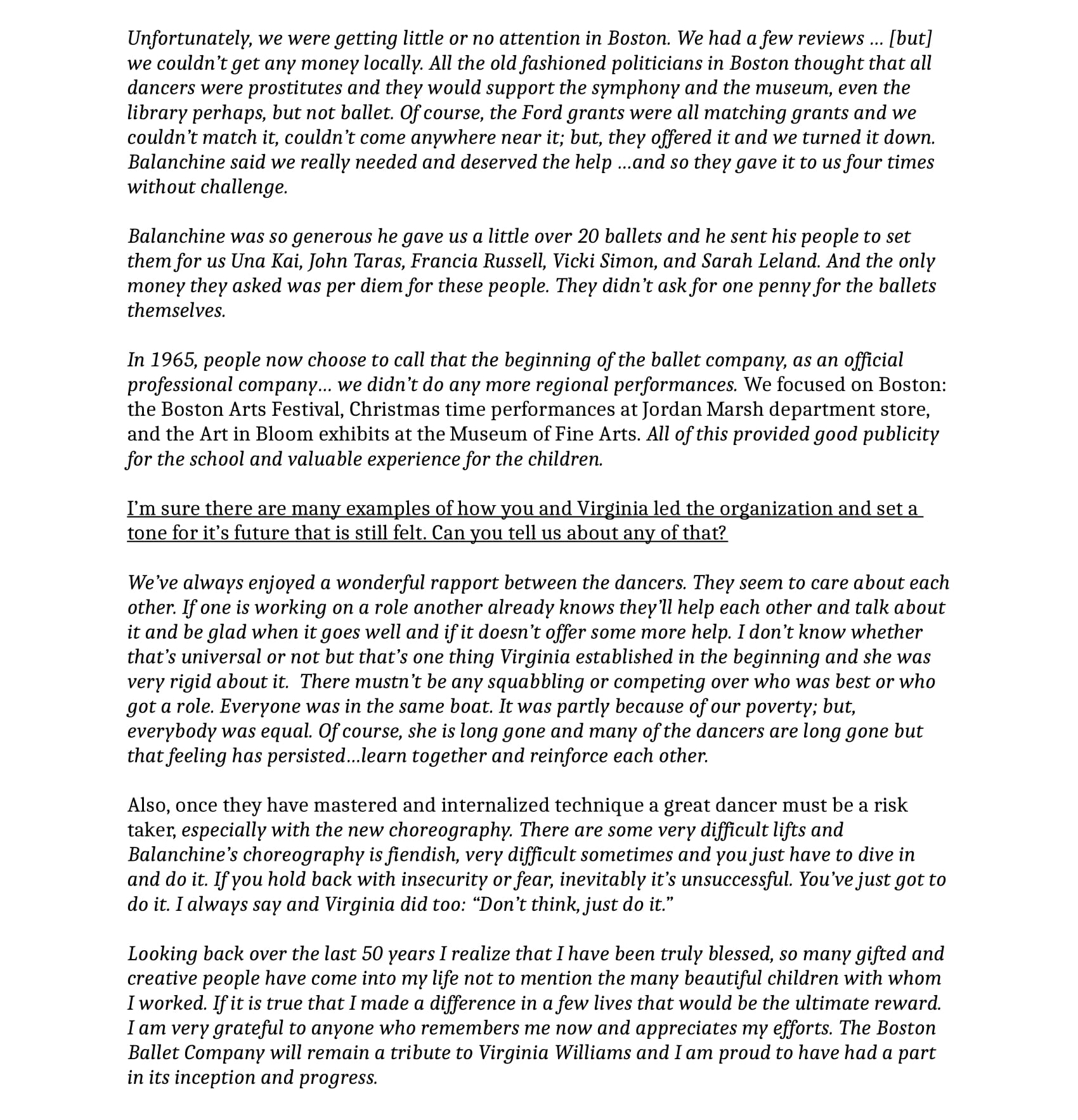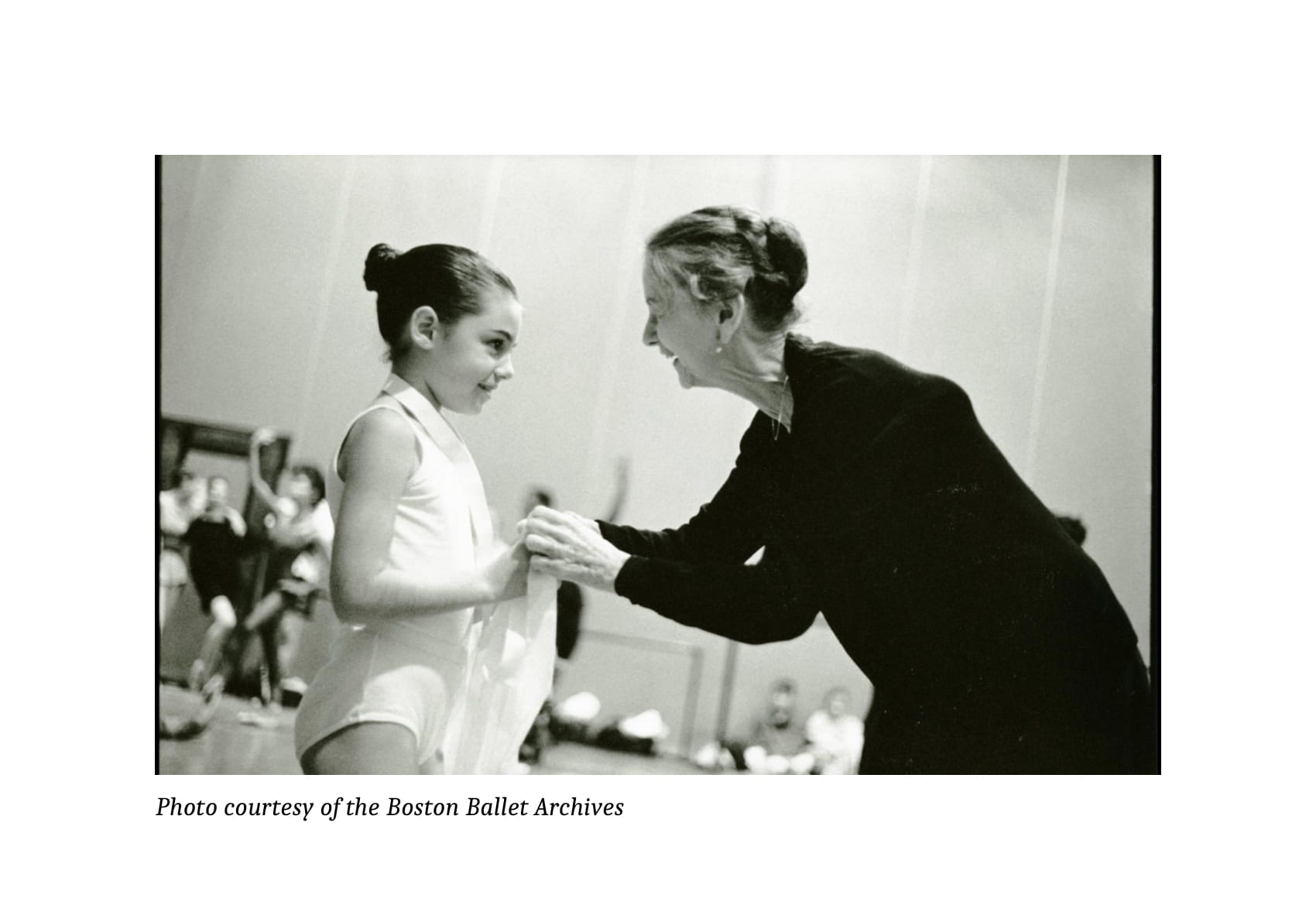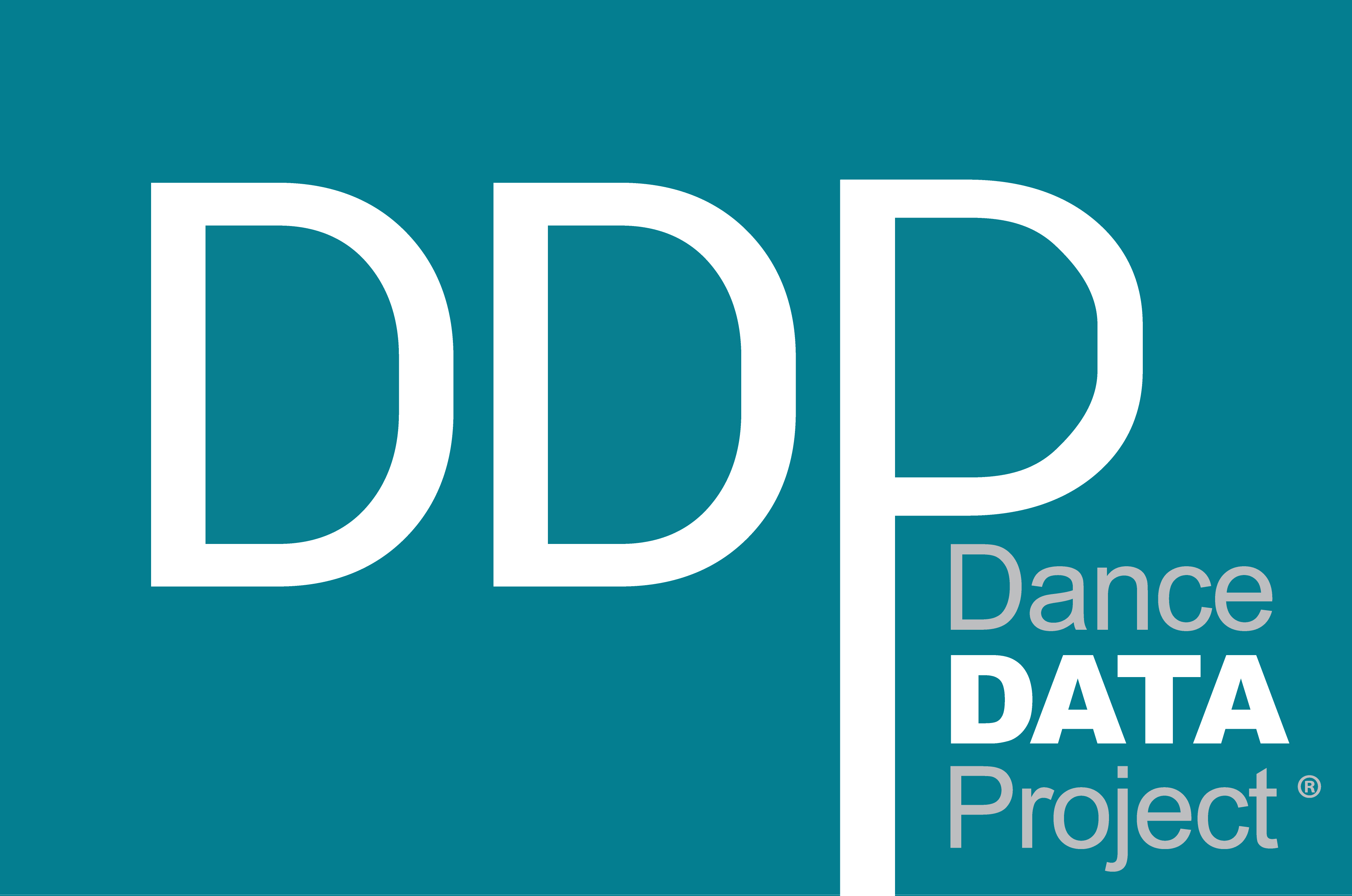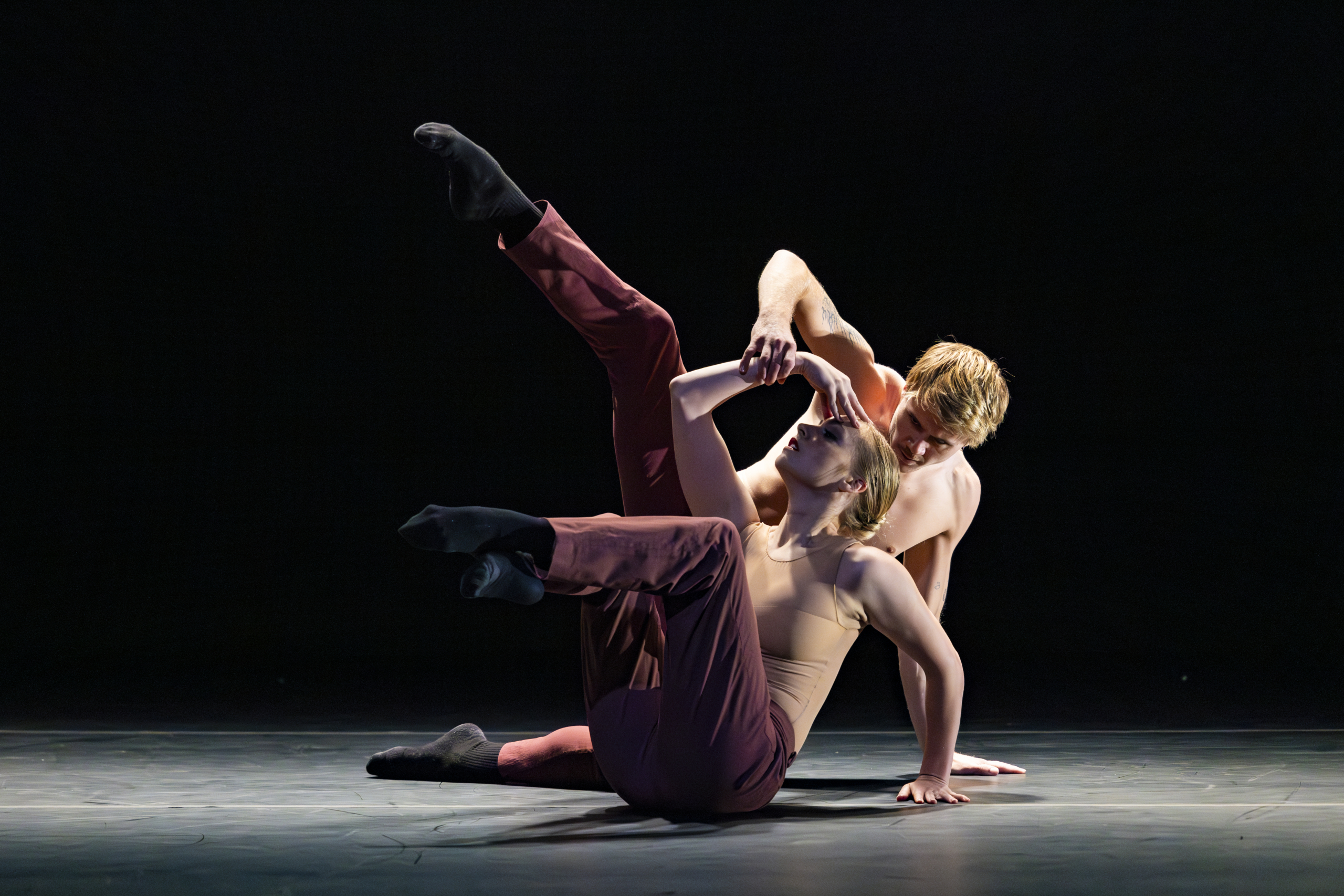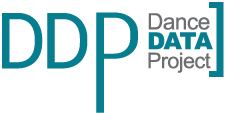Innovation and Entrepreneurship
Mini-Interviews
The following interviews were originally included in DDP’s September 2023 Newsletter on Innovation & Entrepreneurship. This edition of our newsletter was designed to celebrate and feature a variety of trailblazing individuals in the dance world. In each of these succinct mini-interviews, DDP spoke with a pioneering founder, director, or choreographer about their work in the dance industry.
Pointeworks - Founder Sophie Williams
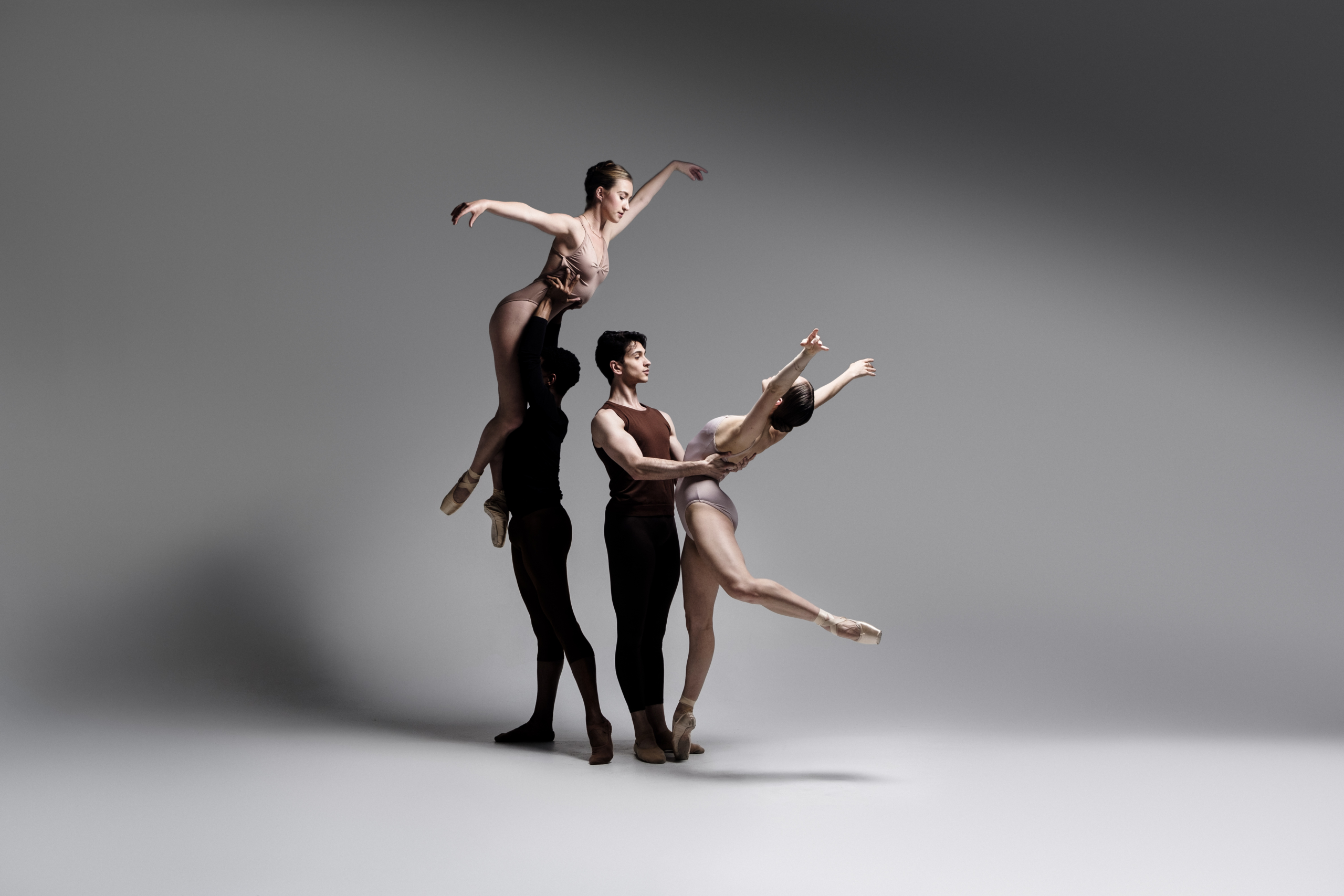
Courtesy of Pointeworks, Photo by Nathan Carlson
1. You’ve just recently founded the new ballet company Pointeworks. Can you tell us about your decision to create a company based in La Jolla, a community with no other ballet companies? Can you also tell us more about the choice to exclusively perform and rehearse during the summer season?
La Jolla is a community with a huge appreciation for music and theater. I was privileged to go to many events growing up here, thus, when I had the idea to create Pointeworks, it was an obvious choice to give back to a community that had given me so much. With such an appreciation of the arts, I saw an enormous untapped potential that Pointeworks could fill. As for the summer season, creative minds never stop so I was inspired to give opportunities to the many artists who are off contract with our main companies in the summer. By bringing together artists in the summer, Pointeworks provides a unique opportunity to work on our artform, create, and perform during a layoff time. For audiences, a summer season is a novel and exciting experience, a fleeting window into a burst of creativity and inspiring newness.
2. Your inaugural performance is scheduled for June 2024 and will feature four female choreographers. In a recent feature in La Jolla Light, you’re quoted as saying: “It’s surprisingly rare to be able to perform a work by a female choreographer. It’s not that they aren’t out there, but I’ve danced for 13 companies and have only performed the work of a female choreographer once. So I want to be able to provide a platform for that as well.” How are you planning to emphasize and prioritize gender equity within the company? And, how will you be building excitement and anticipation a year out from your inaugural performance?
I am passionate about giving a voice to females. At the heart of Pointeworks, our vision is female-driven, our works will be by female choreographers, and our mission is to create a platform to elevate, highlight, and appreciate the underrepresented voices of female artists in dance. Our dancers epitomize gender equity, with four female and four male dancers. But our leadership and our choreographers aim to level male-dominated positions and provide opportunities to females. Our enthusiasm and anticipation are already growing! We’ve launched works digitally through collaboration with Marquee TV and social media. As Pointeworks prepares to take the stage, we hope to keep building the excitement, as we share the step-by-step process of our creations with our followers, artists, and future audiences!
3. As a founder and entrepreneur in the dance industry, what kind of executive planning was involved in starting the company? How do you plan to promote the company, expand your reach, and attract audiences?
In February of this year, I was rehearsing a triple bill by all male choreographers, and heading into a layoff week. I was struck by one thought that I could not get out of my head: it was beyond time a female voice had a say. As DDP has documented so effectively and with so much data, ballet is female, we make up the majority of ballet students, dancers, and audience members, and yet we are in the minority at the front of the room. We can’t passively sit back and wait for that to change. It is on us if we want to see change, and it is on our generation of dancers to make it happen. This is something I feel very passionately about, and I am highly committed to making a difference. That night I went home, started my 501c3 application, and Pointeworks was born.
Artistically I have absolute faith in my dancers, my choreographers, and the creative female energy that is driving Pointeworks. Having a team full of passion, creativity, and love of this art form combined with our uniquely female vision creates excitement and a draw to audiences as we fill a void that much of the dance world has left untapped. Our first initiative to reach audiences is digitally; we have embarked on a 2-year contract with Marquee TV to give an online platform for our project. We hope to gain momentum digitally, and progress to engaging with a live audience base for our inaugural 2024 performances.
4. Do you have any prior administrative experience that has helped you in these early stages of founding the company? Your website and media assets are especially cohesive and effective; do you have previous experience in that area, or are you just more of a natural leader?
In my career as a dancer, I have had the immense privilege of working for a range of directors and experiencing the direct impact of their unique leadership upon myself, my colleagues, and their respective organizations. Drawing from all those experiences has helped me shape my vision for Pointeworks. Specifically, while working at the Royal New Zealand Ballet, I had great admiration for Patricia Barker’s initiative to program female choreographers, a concept that I replicated and put at the core of Pointeworks. At BalletMet, I observed invaluable leadership skills from Maria Torija. And, even while growing up, I had the influence of my mother, Alexandra Newton, whose leadership skills as the first female Canadian President of The International Union of Biochemistry and Molecular Biology have been inspirational to me.
Asian American Ballet Project - Artistic Director Elizabeth Mochizuki

Asian American Ballet Project in The Sleeping Beauty, Photo by Nicole Marie Photography
1. The Asian American Ballet Project was founded in 2022 as the first Asian American ballet company. What was your motivation to found this company and how do you plan to tackle your goal of authentically retelling classical ballet stories?
Almost every little girl takes ballet at some point during her childhood; I started with creative dance at age 3 and never looked back! Even though ballet has its origins in Europe, it plays such a large role in the lives of Americans. However, the ballet world doesn’t always feel welcoming, especially to people of color. As I progressed in my own career, I became disillusioned as an artist; the ballets I was being asked to dance didn’t feel like the art I wanted to be presenting. I founded the company to provide opportunities for Asian American dancers to build community, work with AAPI choreographers, and present classical ballet in a way that is more meaningful. My dancers have opportunities to perform new and classical repertoire staged to acknowledge and celebrate our racial identity.
When it comes to the classics, ballet’s canon is well-loved for a reason: the romantic music, the synchronized corps de ballet, and the bravura of the principal dancers – these ballets are amazing artistic achievements. I want to be able to present these works through an Asian American lens. This means eliminating problematic messaging and stereotypes. It might also mean preserving the original choreography but changing the setting or storyline. In our inaugural performance, I staged an excerpt of Sleeping Beauty, which is – in my opinion – one of the only classics that I feel is elastic enough in its origins that it could be anyone’s story. What felt fresh to me about our rendition, even though we stayed true to the classical choreography, was simply that each fairy was portrayed by an Asian American dancer.
2. Part of the company’s mission is to: “Provide the unique opportunity for Asian American ballet dancers to work alongside artists with the same racial background,” while also offering “a supportive community to these dancers, celebrating their talents, and valuing their backgrounds.” What sort of resources and opportunities do you offer to create this supportive community? How do you plan to further expand those opportunities as the company grows?
It’s so rare for Asian American dancers to feel we are in the majority in the ballet studio. I know in my own career I often felt overlooked and isolated. It is really critical for me to share with each of my dancers that their presence is intentional and important. We are building community one step at a time by introducing AAPI choreographers, teachers, designers, etc. who want to work with this group of dancers specifically. As the company grows, I hope to provide more opportunities for the dancers to choreograph and take on leadership roles.
3. The company’s current artistic staff includes Hyung Ji Yu, an international choreographer, dancer, and instructor. As a female founder, how do you plan to continue uplifting both female artists in addition to Asian American dancers and choreographers?
I was thrilled when Heidi (Hyung Ji Yu) agreed to choreograph for our inaugural performance. It is really important to me to have a balance of male and female choreographers; next season I anticipate that at least half of our choreographers will be female again. I am relieved that I can offer work to these women who don’t always have as many doors open to them as their male counterparts. There are so many talented female artists, especially in the ballet world. If directors give these artists a chance, they have so much to offer.
4. This past July, you presented Beginnings, the company’s inaugural performance both in-person and digitally. Tell us about the work that was presented as part of this program, as well as your plans for upcoming performances and events.
My goal with Beginnings was to show the range of the company so the dancers performed the excerpt from Sleeping Beauty that I mentioned and Heidi set a contemporary ballet entitled Unspoken Words. Her inspiration was the thought processes that take place for bilingual folks but she has a knack for creating interesting movement that audience members can interpret for themselves. Junichi Fukuda set Anima/Animus, another contemporary world premiere on the company which explored the boundaries between femininity and masculinity. And, Michael Lowe choreographed Suho and the White Horse, a Mongolian folktale detailing the origin of the horse-head fiddle, the Morin Khuur. The dancers are off now but they will go back on contract in May or June and, until then I’m working to fundraise and strategize around the next concert. I’m in the process of developing our second production slated for next summer. Nothing is set in stone yet, but I hope to present 4 ballets again spanning the classical to contemporary range as a way of continuing to introduce the company and our mission.
Hollywood Ballet - Artistic Director Petra Conti
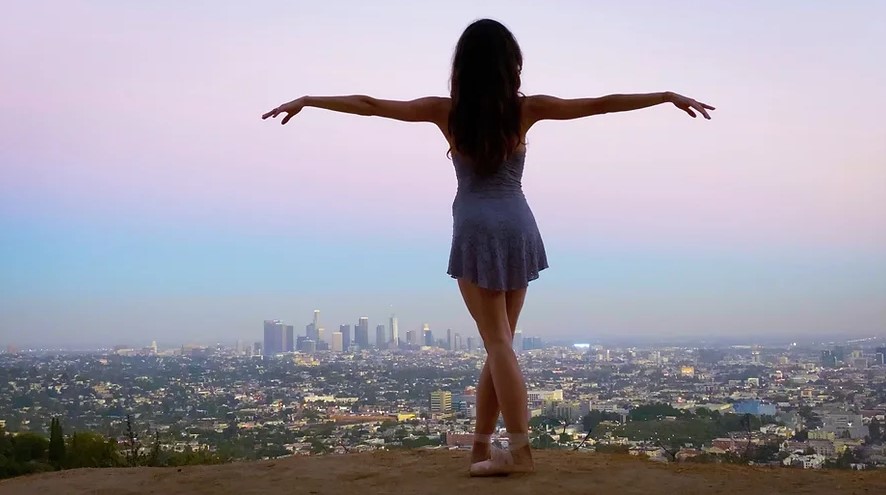
Courtesy of Hollywood Ballet
1. Hollywood Ballet was just recently founded and will soon be releasing information about auditions and a performance schedule. What motivated you to found a company and what are your goals for this first year in operation?
Hollywood Ballet comes from our passion for both ballet and for Hollywood. We want to take ballet to the big screen and the big screen to ballet. We want to adapt movies into ballets as well as write and produce stories set in the ballet world for the screen. We’d also like to collaborate with artists from various fields to create dance pieces inspired by Hollywood iconic figures as well as stories from the dark streets of Hollywood.
As for our near goals, this past August, we had an amazing inaugural party and first show (ever!) at the historic Ebell Theater of Los Angeles. It was truly a magical night for us and our guests and we’re now moving into the fundraising, the creation, and the production of our next show.
2. Your website explains that you’re planning to bring both traditional classical ballets and innovative new works to Southern California; how are you going to make your work appeal to the audiences of Hollywood?
People come to the theater to see themselves and we’re bringing Hollywood to Hollywood. On a larger scale, Hollywood tells stories from all over the world and people from all over the world can see themselves in a Hollywood story. As for the ballet classics, they might be appealing to an audience who hasn’t seen them yet—and, of course, they are always appealing to connoisseurs. In our first show, we have presented two classic pas de deux from Swan Lake and Don Quixote along with a commissioned contemporary piece by Leah McCall (Clouds, The Mind On The (Re)Wind), a Broadway-style piece by Andre Megerdichian (Sing Sing Sing), a classical ballet Overture choreographed by ten-year-old Alianna Nassos, one duet inspired by the movie Ghost re-imagined by Eris Nezha, and a pulp creation by Gianluca Schiavoni, Blackstone. Everything is accompanied by the Dream Orchestra of Los Angeles directed by Daniel Suk with intermezzos by comedians. And, even a very touching poem by Charles Bukowski has made its way into the show!
3. Your website explains that one of the company’s goals is “to create a work environment that supports the physical, mental, spiritual, and financial health of all our Members and Collaborators.”How are you planning to accomplish this? What makes Hollywood Ballet different from other companies in this endeavor?
Obviously, we need funds and we’re putting a major effort into finding economic resources through private donors and corporations. When it comes to managing those resources, for our first show we have already offered a very competitive pay to our dancers and all our collaborators and we hope to be able to continue in this way.
We also offer experienced mentorship and ballet classes to both professional dancers and trainees and, for our first show, we have given the advanced students of our school partner, Pasadena Civic Ballet, the opportunity to work with all our choreographers and dance with our professional dancers and they have all done an incredible job on stage! And, our trainees received pay for the show, which is something extremely rare in a ballet company, given the fact that usually trainees don’t get paid or even pay tuition.
4. Your professional dance career has been extensive, performing as a principal dancer with La Scala, Boston Ballet, and Los Angeles Ballet, in addition to traveling the world as a freelance dancer. How will this background help you succeed as a director? What other professional experiences have helped you in the early stages of establishing the company?
I’m still navigating these first months as the artistic director of Hollywood Ballet and I’m trying to reconcile that role with my usual role of prima ballerina… and wife, since the co-founder and vice-artistic director of Hollywood Ballet is my husband Eris Nezha! I have also taken some college classes in business management and I have hired two collaborators. As for the rest, I guess I will rely on the old wisdom of “live and learn” and “one day at a time!”
Deos Contemporary Ballet - Artistic Director & Resident Choreographer Tess Sinke
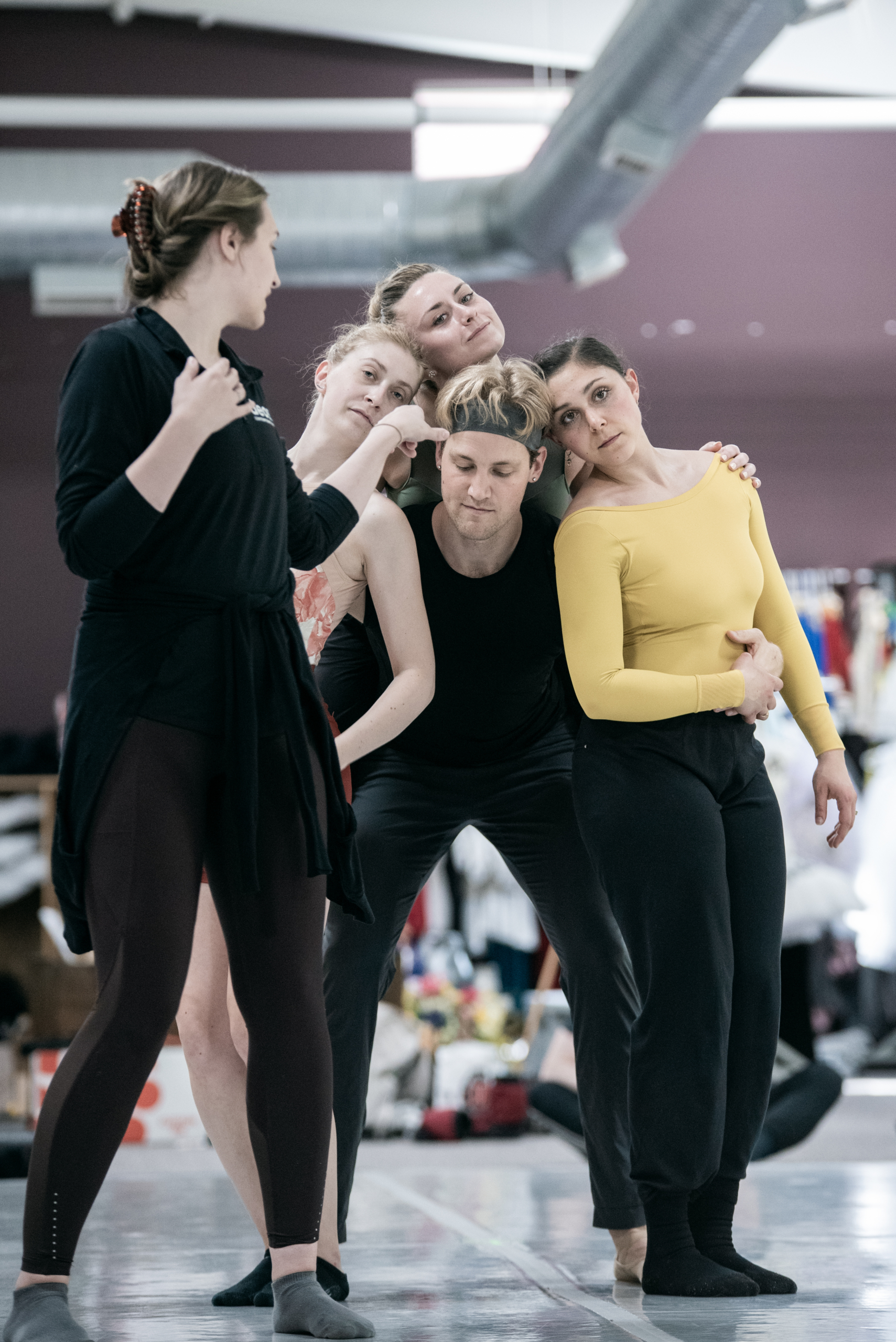
Deos Contemporary Ballet in rehearsal with Tess Sinke, Photo by Jon Clay Photography
1. Deos Contemporary Ballet just recently finished up its first full season. What have you learned from this first year and how have your goals for the company changed or expanded?
While Deos has been around since 2018, last season was our first operating year-round with 4 full repertoire performances as well as collaborating with our partner school, Michigan Ballet Academy for Nutcracker and their spring show. Having grown slowly from just summer performances to year-round made this transition feel natural. We’ve had time to get best practices put into place, so we were prepared to take the big step of year-round operations. We now have six professional dancers working as W2 employees with us all year. There is definitely a learning curve that goes hand in hand with growth. We’ve had to adapt to changes as a team. Open communication, setting clear expectations, and giving the dancers transparency have helped set us up for success during these major changes.
2. Since the company’s founding, you have expanded significantly to provide your year-round dancers with more extensive performance opportunities as well as increased benefits and professional support. In what specific ways have you improved their experience not just as artists, but as employees?
One of the things I talk about often with the Deos dancers is “people first, art second.” I don’t care how much of a creative genius someone is, that should never give anyone the right to treat other people poorly. We try very hard at Deos, despite being new and with a small budget, to always put our employees’ best interests behind every decision we make. This means soliciting feedback, often from all our partners, to make sure the decisions and plans are in line with their wants and needs. We recently transitioned our year-round employees to W2 employees with paid time off and zero layoffs. This means even during the summer months our dancers can always expect a steady paycheck. It was incredibly important to us that our dancers have consistency with pay no matter what time of year it is. The dancers know that we expect to work with them long term, for years to come, and don’t need to fear losing their contract for next season at the last minute.
We also work with Athletico Physical Therapy to provide PT for our dancers. We are very intentional with the number of hours we rehearse, the types of teachers running company classes, the guest choreographers we bring in, and incorporating Progressive Ballet Technique and conditioning into our workdays, which are all part of our people-first culture. We know that the amount of support we can offer our dancers currently is still falling short. This is why we are doing the hard work now of laying a solid foundation to ensure that as we grow, the artists we work with will always be our priority. When you truly put the people who make up your organization first, you get great art. Each one of the dancers we work with puts in a tremendous amount of work in the studio and on stage, they give their all every performance – because they know we have their back. They know they are supported and matter and at the end of the day they are so much more important than any piece of art we create together. Knowing that, together we are able to make something spectacular.
3. Your mission is focused on prioritizing and uplifting your dancers: “We center the business around the professional dancer, period. We are built on movement — our dancers are our most important partners.” In looking at how the dance industry often undervalues female artists; in what ways do you support gender equity and sustain women in your company?
Elevating women’s stories throughout all of history is so important. Beyond us bringing in female guest choreographers, rehearsal directors, etc. We also elevate women through the work we perform. I’m especially driven to create work that is based on oftentimes forgotten stories throughout history – especially women’s stories. In fact, our upcoming performances are a great example of this. We will be bringing our original contemporary ballet, Trifles, to the stage on the last weekend of September. Trifles is a full-length ballet based on the feminist play written in 1916 by Susan Glaspell. The ballet is centered around women being forced into silence while the men control the law. This coming March, during our EMBER Series 24 performances, we will be premiering a new work titled Locked Doors, which follows the lives of 6 young factory workers who all perished in the tragic Triangle Shirtwaist Factory on March 25, 1911. This historical event took the lives of 146 garment workers, 123 of which were young women, most of whom were 14 – 23 and recent immigrants. Bringing stories like these to life continues to remind audiences how far we have come, and how far we have yet to go. We’ve done pieces in the past that focus on miscarriages, Mothers losing their sons to war, and the internal strength that women possess. As a female director, choreographer, and Mom, highlighting the voices of women continues to be one of our pillars at Deos. Every day I get to work with six incredibly strong and resilient women who each bring their own unique voice to the work we do, I’m excited for our organization’s continued growth.
Dance Aspen - Founder & Executive Director Laurel Winton
1. Dance Aspen was founded in 2021 in response to the disbanding of Aspen Santa Fe Ballet. Your website describes the situation with the following quote: “This news left the dancers with two options; stay in Aspen and retire from their professional dancing careers or move and leave behind the lives and communities they built in Aspen. Stuck between a rock and a hard place, the dancers banded together to create a third option… fill the void left behind and create a new company. From here, DanceAspen was formed.” What was challenging and rewarding about founding a company in those unique circumstances? How does your model of leadership differ from other companies?
The challenging aspect was that the world was changing as we knew it, and there was no stability or prediction of how the dance industry was going to settle back into existence or how things were going to look for our careers on the other side of the pandemic. The exciting part of it was that this uncertainty gave us the space to carve out a new way of doing things and the drive and fearlessness to go for it. We had already lost our jobs so what more could we lose? A lot of companies, especially companies that have been around for a while, have a very traditional structure of leadership. There are the dancers who report to a rehearsal director who then reports to an artistic director who usually makes artistic decisions outside of both parties.
We started this company as a collection of artists and the identity of DanceAspen has been collectively realized. Yes, there is a chain of command as is necessary, but when I’m choosing a new choreographer or building a new program, I ask the artists who they would like to work with, they are part of the artistic decision. As we do not have a full-time rehearsal director, I also depend on them to look out for one another on a daily basis. There is a sense of responsibility that I try to instill within the company that a single artist has a huge impact on whether or not we are successful. Your behavior, work, and focus matter not just for your own growth and promotion, but the growth and health of the unit.
2. How has your experience been in a city like Aspen, one that is geographically smaller than other cities with professional dance companies, but that contains a vibrant arts community?
Aspen is a very unique place. It’s a small town with access to the level of arts and culture you would find in New York. The wonderful thing about the small town structure is that people are much more in touch with their community and they really care about their neighbors and take initiative when it comes to supporting and maintaining the art and culture they value. What sets Aspen apart from any other mountain town is it’s arts and culture and there is a local pride about this. I would say the challenges are that, while a company in a large city can do two weeks of shows with plenty of people to go to every performance, we can only do a certain amount of the same show before everyone has seen it. This is hard, but keeps us always creating and evolving the work we do. Also, we are physically hard to get to, and without access to a major metropolitan area, we often have to work with artists in other areas when it comes to costume design, etc.
3. The company just recently performed at the Vail Dance Festival for the second year in a row. Tell us about the work you presented this year, as well as any other upcoming events and performances.
We presented Plim, which was actually created for Vail Dance Festival’s NOW premieres and co-commissioned by the festival and Damian Woetzel. This was a very special work choreographed by Matthew Neenan, whom I have known since my early years as a professional ballerina. Matthew has a fantastic musicality and dynamic approach to his work, and the results were beautiful. It was a lovely process for the dancer and creator and it was so wonderful for me to watch it unfold. Plim received a standing ovation at the Now premiere and it was such an honor to hear such wonderful feedback about the company and from such esteemed individuals. I have a huge respect and appreciation for Damian Woetzel and Heather Watts for taking a chance on our young company and helping us grow artistically through the opportunities of the past two years.
An overview of the 2023 season: Earlier this year we had our Winter/ Spring program, which featured two world premieres created on DanceAspen. One by Yin Yue and one by Penny Saunders. This summer we collaborated with the Music Festival. Our in-house choreographer Matthew Gilmore created a piece with the dancers for the festival’s iconic July 4th celebration. Throughout the summer, we had our adult class series and added a beginner class series so anyone in the community had the opportunity to start learning the fundamentals of ballet. We collaborated with Aspen Public Radio on their fundraising event, as well as performed at the “Space for Giants” gala, bringing awareness to the international nonprofit’s mission to support the remaining natural ecosystems across Africa. We curated our first “Wine Flight” series, a collaboration with the Jerome Hotel to pair dance with exquisite wines, and premiered our highly anticipated Solstice program. Solstice included the full work of Matthew Neenan’s Plim as well as the North American premiere of Cayetano Soto’s Contracorriente and the DanceAspen premiere of his Sortijas. We brought back a crowd favorite, Danielle Rowe’s Everyone’s in St Barth’s and, after our Aspen shows, we took this program on tour to Crested Butte and Lone Tree, CO. This winter will be the first time we collaborate with the Wheeler Opera House on a holiday performance. Our “Snowy Soiree” is geared to families and ticket prices are in the $10-$15 to make the experience affordable for all.
4. The company’s mission is to cultivate relationships with the local community, while further enriching the caliber of dance in the area. What have you already accomplished in working towards this goal, and how do you plan to further expand on your mission and work moving forward?
Yes, DanceAspen is all about supporting other local organizations and working together to enhance each other’s impact on the community. So far we have built partnerships with the Aspen Art Museum, Theatre Aspen, the Aspen Music Festival, and Jerome Hotel, to name a few. We hold seasonal workshops and rehearsal viewings free to the community at the Aspen Art Museum, have collaborated with both Theatre Aspen and the Music Festival for their programming, and curated a program called “Take Flight” with the Jerome Hotel, in which we team up with the hotel’s master sommelier to create an immersive dance and wine tasting. We have also generated a series of adult and young adult beginner/ intermediate ballet classes so anyone in the community can begin or continue to learn ballet. This winter will be the first time we collaborate with the Wheeler Opera House on a holiday performance. Our “Snowy Soiree” is geared to families and ticket prices are in the $10-$15 to make the experience affordable for all.
Indy Dance Festival - Indy Dance Council Managing Director Sarah Farnsley

Indianapolis Ballet in Kristen Toner’s Veiled Visions, Indy Dance Festival, Photo by Indy Dance Photography
1. Tell us about your work as Managing Director of Indy Dance Council, as well as a brief overview of the Indy Dance Festival’s history and mission.
When Indy Dance Council’s founder, Mariel Greenlee-Lungu, approached me to assist in developing an organization to support dance in Indianapolis, I knew I wanted to be part of it. From the start, Mariel had dreams of creating a dance festival that would be the physical embodiment of IDC’s mission to connect and organize the Indianapolis dance scene and make it more visible to the greater community. Fortunately, Mariel and I have quite complementary skill sets, and in just a few months of incredibly hard work, the inaugural Indy Dance Festival was held. This event, and other efforts by IDC, are actively catalyzing growth for our local dance community, as well as further developing our audience base and resource pool. We want to inclusively promote all of the incredible dance that is already happening in Indianapolis and the festival is now a big part of that.
2. The 2023 Indy Dance Festival took place this past July. Could you tell us more about the programming selections this summer, as well as some of the other masterclasses and events that were offered?
This year’s festival featured 18 local professional groups split over 2 nights of performances. The shows were anchored by Indianapolis Ballet and Dance Kaleidoscope, our largest professional companies, and were opened by youth-centered dance organizations Kids Dance Outreach and iibada Dance Company. The rest of the performers applied to take part and were carefully selected and programmed by a designated adjudication panel, presenting a huge range of styles including street dance, ballet, K-pop, tap, classical Indian, modern, breaking, contemporary, and more. During the days we offered masterclasses in a variety of styles including contemporary, hip hop, popping, ballet, Horton modern, commercial jazz, bollywood, Graham modern, and musical theatre. Classes were taught by an incredible selection of teachers from across the country, all with a connection to or passion for Indianapolis. Finally, we offered 3 lecture panel discussions, free of charge and open to the community, about:
- Health & Wellness: Taking care of the whole instrument, mind, and body, in order to perform at your peak.
- Culture & Context: How studying the history and culture of the dance you love can enrich your experience and improve your craft.
- For Dance Educators: Creating safe spaces and improving accessibility in our studios and performance venues
3. More summer dance festivals are being created every year; what work have you done to set Indy Dance Festival apart from the rest?
It was so important to us to create a space that is supportive, not competitive. We wanted to develop an event that would build creative bridges and expand the artistic network of both the artists and the audience. The Indy Dance Festival was the first of its kind in Indianapolis, and we were so overwhelmed by the positive response. We worked hard to ensure we programmed a diverse mix of artists, some of whom had never performed in a theatre or concert setting before. Every piece was lit by a professional designer (also a first for many of the performers!) and we were able to provide all performers with professional photos and video footage of their work. Bringing together so many different artists in one setting provided an opportunity for everyone involved to reach new audiences who might not have seen or heard of them before. By combining national-level talent and high production value, the performances were a chance to showcase the diversity and greatness present in our city, making the Indy Dance Festival a truly unique event.
4. One of the festival’s goals is to invite “the whole community to come together, connect, and celebrate the dance” present in Indianapolis. What other opportunities do you provide throughout the year to support and enhance that community?
The Indy Dance Council is still a young organization, but we have big dreams of what we can grow into. Coming up this October we are partnering with the acclaimed Heartland International Film Festival to present Seda Negra/Black Silk. The company will perform a work preceding a screening of one of this year’s films, with parallel messages rooted in freedom, expression, and the power of the arts. We will be co-hosting a Teachers’ Workshop for local dance educators in December at the Dance Kaleidoscope School, taught by our friends from TDA Prep in Chicago, and in January, we will be presenting an evening of Indy dance films at the Kan-Kan, a local boutique cinema. Our goal is to create opportunities, foster collaborations, and program events that remind everyone that dance is an essential part of our city’s cultural landscape, and it’s happening all around us. For news on spring events please follow us on Instagram (@indydancecouncil) and subscribe to our quarterly newsletter via our website!
Alexandra F. Light
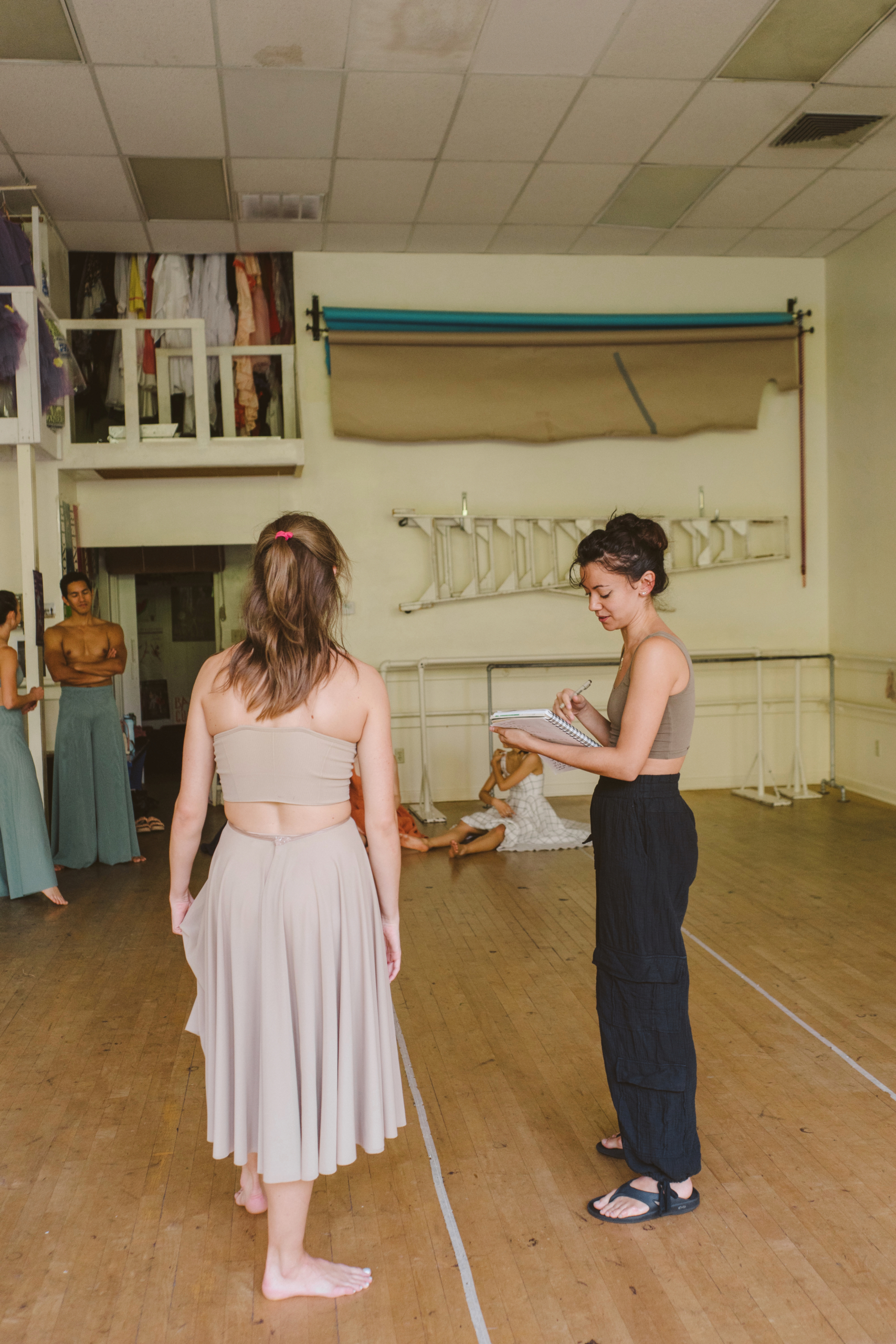
Rehearsal with Alexandra F. Light, Photo by Joe Johnson
1. You have had a long and distinguished career as a Principal Dancer at Texas Ballet Theatre. When and how did you decide to also begin choreographing?
Choreography was something I did from a very young age; I have memories from about age 11 of getting together with girls from my ballet class and our parents helping us put on a show for our local nursing home that I choreographed for us- we just loved dancing so much. It is strange how only as I began my professional career that these desires seemed to wane, and I put becoming a repetiteur first in my mind. I think there is something to be said that in my career roughly 90% of repetiteurs I have worked with for the company have been women, but 0% of the choreographers commissioned by TBT have been. I think, on an unconscious level, I felt like choreography wasn’t my place somehow, and it kept this passion of mine hiding inside for too long. I am happy to have returned full-force to choreography in 2019 and have not slowed down since.
2. Our 2022/2023 Season Overview Report found that Texas Ballet Theatre, along with Ballet Arizona, Ballet Memphis, and the Alabama Ballet did not feature any works choreographed by women for the 2022/2023 season. What has it been like trying to find opportunities to choreograph within Texas Ballet Theatre?
It is definitely a challenge to be in a company that has never commissioned a female choreographer, but I work extraordinarily hard to see the tide rise for all ships. I am really fortunate to be a part of the larger arts community here, and the Modern Art Museum of Fort Worth has supported four presentations of new choreography from me over the last two years. I am always looking for outside-the-box opportunities; this has led to some incredible experiences that have grown my work exponentially, including commissions for record labels, artist residencies, and performance artists.
3. Can you tell us about some of your other projects and commissions, including your recent piece for Frank Lloyd Wright’s Martin House Creative Residency Program?
The Martin House Creative Residency is a huge accomplishment for me; to know my proposal was selected as the first of two, out of a whopping 353 applications, from all over the world and all mediums, was quite an honor. The work I created there was titled Floricycle: a 17-minute contemporary ballet work performed for the public on site. It told the stories of five women integral to the life and work of Frank Lloyd Wright but who are often forgotten by history. Additionally, I worked with musician Sigrid Karlstrom to resurrect composer Marion Bauer’s Op. 22; Bauer was one of the greatest composers of the 20th century, but is often left out of the story for some reason. Bauer also is of Jewish descent, and I love to bring parts of my heritage to my work. It was a very cathartic work in a lot of ways for me. And to bring dance (back!) to the Frank Lloyd Wright legacy for the first time in too long, what an honor! Living in the home was pretty spectacular as well. It is currently in post-production in a beautiful short film version for a wider community distribution; shot all over the stunning 100+ year old home, I cannot wait to present this aspect of the project more broadly.
4. What role have you seen Dance Data Project® play in the dance industry? How can we better serve other female dancers, choreographers, and innovators like yourself?
Dance Data Project® is bringing to light issues that have gone under the radar for much too long. Without this research, companies would continue to be able to ignore one of the largest discrimination issues our society faces, and the ballet world is one of the worst culprits. Now that the numbers are so clear, I hope that accountability for the gender gap will start to grow. Not only does DDP give data-driven evidence of long-standing issues, but it is also a platform of hope, community, and inspiration! I think the proof is in the pudding- the fact that you ask how you can better serve creators is evidence that the DDP team really cares about bettering the ballet world that so desperately needs help. At the moment, it is hard to say anything could be done better on your end! But I know that if I ever have a question or concern, I have a community I can talk about it with who are actively listening.
Sydney Leonard
Sydney Leonard and E. Virginia Williams were co-founders of the Boston Ballet School and Company. Miss Leonard, as she was known by her thousands of students, died in 2020 at the age of 100. Sydney was not only a founder and entrepreneur, but also an innovative and trailblazing female leader. We’re excited to share an excerpt from Boston Ballet’s interview with Sydney below.

